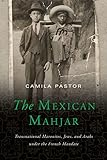The Mexican Mahjar : Transnational Maronites, Jews, and Arabs under the French Mandate / Camila Pastor.
Material type: TextPublisher: Austin : University of Texas Press, [2021]Copyright date: ©2017Description: 1 online resource (337 p.)Content type:
TextPublisher: Austin : University of Texas Press, [2021]Copyright date: ©2017Description: 1 online resource (337 p.)Content type: - 9781477314630
- Arabs -- Mexico -- History -- 20th century
- Arabs-Mexico-History-20th century
- Jews -- Mexico -- History -- 20th century
- Jews-Mexico-History-20th century
- Maronites -- Mexico -- History -- 20th century
- Maronites-Mexico-History-20th century
- Mexico-Emigration and immigration
- Middle East-Emigration and immigration
- HISTORY / General
- 305.800972 23
- F1392.A7 P37 2017
- online - DeGruyter
| Item type | Current library | Call number | URL | Status | Notes | Barcode | |
|---|---|---|---|---|---|---|---|
 eBook
eBook
|
Biblioteca "Angelicum" Pont. Univ. S.Tommaso d'Aquino Nuvola online | online - DeGruyter (Browse shelf(Opens below)) | Online access | Not for loan (Accesso limitato) | Accesso per gli utenti autorizzati / Access for authorized users | (dgr)9781477314630 |
Browsing Biblioteca "Angelicum" Pont. Univ. S.Tommaso d'Aquino shelves, Shelving location: Nuvola online Close shelf browser (Hides shelf browser)

|

|

|

|

|

|

|
||
| online - DeGruyter Hysterical! : Women in American Comedy / | online - DeGruyter Misinformation and Mass Audiences / | online - DeGruyter The Independent Republic of Arequipa : Making Regional Culture in the Andes / | online - DeGruyter The Mexican Mahjar : Transnational Maronites, Jews, and Arabs under the French Mandate / | online - DeGruyter Power Moves : Transportation, Politics, and Development in Houston / | online - DeGruyter Books Are Made Out of Books : A Guide to Cormac McCarthy's Literary Influences / | online - DeGruyter Andean Cosmopolitans : Seeking Justice and Reward at the Spanish Royal Court / |
Frontmatter -- Contents -- Illustrations and Tables -- Acknowledgments -- Introduction -- Chapter 1 The Mexican Mahjar -- Chapter 2 Managing Mobility -- Chapter 3 Race and Patronage -- Chapter 4 Migrants and the Law -- Chapter 5 Modernism -- Chapter 6 Making the Mahjar Lebanese -- Chapter 7 Objects of Memory -- Chapter 8 The Arab and Its Double -- Conclusion -- Notes -- Bibliography -- Index
restricted access online access with authorization star
http://purl.org/coar/access_right/c_16ec
Migration from the Middle East brought hundreds of thousands of people to the Americas in the late nineteenth and early twentieth centuries. By the time the Ottoman political system collapsed in 1918, over a third of the population of the Mashriq, i.e. the Levant, had made the transatlantic journey. This intense mobility was interrupted by World War I but resumed in the 1920s and continued through the late 1940s under the French Mandate. Many migrants returned to their homelands, but the rest concentrated in Brazil, Argentina, the United States, Haiti, and Mexico, building transnational lives. The Mexican Mahjar provides the first global history of Middle Eastern migrations to Mexico. Making unprecedented use of French colonial archives and historical ethnography, Camila Pastor examines how French colonial control over Syria and Lebanon affected the migrants. Tracing issues of class, race, and gender through the decades of increased immigration to Mexico and looking at the narratives created by the Mahjaris (migrants) themselves in both their old and new homes, Pastor sheds new light on the creation of transnational networks at the intersection of Arab, French, and Mexican colonial modernisms. Revealing how migrants experienced mobility as conquest, diaspora, exile, or pilgrimage, The Mexican Mahjar tracks global history on an intimate scale.
Mode of access: Internet via World Wide Web.
In English.
Description based on online resource; title from PDF title page (publisher's Web site, viewed 26. Apr 2022)


